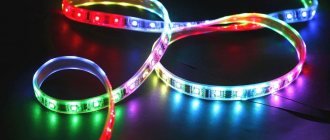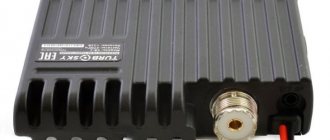The high quality images of modern TVs are made possible thanks to LED backlighting. A new type of backlight has made a real revolution in the field of electronics.
Thanks to new technologies, color quality and image brightness have significantly improved. TV manufacturers currently use 2 types of backlights - direct led or edge led.
Each type has its own pros and cons, so before purchasing you need to decide on the required lighting.
Advantages and disadvantages of LED backlighting
Before the advent of LED backlighting, the type CCFL (Cold Cathode Fluorescent Lamps) was used - fluorescent lamps. They did not allow deep black tones to be realized, it was difficult to create a high-quality color range, and the service life of the lamps was limited. In addition, fluorescent light bulbs contained mercury, which is not environmentally friendly and causes problems during disposal.
Modern LED TV is a representative of liquid crystal panels. The LED backlight of the TV is based on light-emitting white or multi-colored diodes. Based on the color of the light sources, the following are distinguished:
- single-color system (white LEDs);
- multi-color system (RGB);
- a mixed version of QD Vision - when quantum dots of green and red colors are introduced onto blue LEDs.
LED technology has its advantages:
- good efficiency;
- reducing the thickness of the TV screen;
- stylish appearance of the device;
- long service life;
- environmentally friendly due to the absence of mercury and other harmful components in LEDs;
- possibility of point control of groups of diodes.
Disadvantages of LED backlight:
- unevenness – eventually spot darkening of the image may appear;
- does not provide a high-quality viewing angle of the LCD screen;
- the high price of TVs with this technology.
LED lighting is also divided into 2 types according to the method of placement - carpet (direct led) and edge (edge led). They differ in the ways of placing emitting diodes and their number.
Types of ice backlight
Edge lighting, also known as edge led or side lighting - in it, the emitters are located along the edges of the matrix, usually on the left and right sides. The emitted light hits the diffuser and is then scattered. The use of edge technology makes it possible to make a thin TV body, but there will be increased demands on the accuracy of the placement of diodes. If the arrangement is violated, glare will appear on the screen.
Carpet lighting (Full HD LED, LED Pro, Direct LED) – diodes are installed directly behind the matrix. With this technology, illumination uniformity increases and segmented control of LED blocks can be used.
Composite LEDs
The screen backlight is created by standard LED components with appropriate current, voltage and power values. The last parameter determines the luminous flux, which is formed by a certain model of LED elements, and the efficiency of the system.
Direct lighting differs from classic RGB. Tri-color LEDs were supposed to improve the color gamut, but this did not work out as there might not be enough color. Therefore, engineers developed other light-emitting diodes to achieve the desired result. The technology currently uses quantum dots or GB-R and RB-G LED diodes. They differ in that in the first case, the blue and green LEDs are combined into one and covered with a red phosphor, and in the second case, red and blue are combined and covered with a green phosphor.
Edge LED backlighting uses small white light-emitting diodes. Each component is responsible for illuminating a specific part of the screen.
Features of edge LED backlight
When using edge led backlight technology, all emitting white diodes are placed on the sides of the screen on a metal substrate. The substrate itself is attached to a part of the matrix that acts as a heat sink. If one of the elements breaks, it is difficult to replace, so you will have to replace the entire bar. This type of backlight is used quite often, as it becomes possible to make ultra-thin TVs.
Important! The lateral placement of LEDs allows for high efficiency. Models with side lighting are more expensive than Direct LED due to the presence of a special reflective surface in the design. It is needed to evenly distribute the backlight and reduce brightness differences.
The maximum brightness level is located around the perimeter of the monitor, so backlighting is possible. They will be especially noticeable in a dark picture. The degree of image illumination is different for each model, so you can find a device with minimal changes in brightness.
What to look for when buying a 4K TV
Full Array LED backlighting with FALD (Full Array Local Dimming) is the best and most affordable technology for 4K LCD/LED TVs. Unfortunately, most major brands only offer it on their flagship models, so a full array with FALD won't be cheap on most 4K TVs.
However, Vizio has developed full-array LED backlighting with FALD in the P-Series and M-Series 4K models in 2021, and both are priced far better than their FALD-enabled rivals from Sony, LG, Samsung and other big brands . So if you're on the budget side but need top-notch local dimming and a full LED array, go for the Vizio M-Series or P-Series TVs.
4K edge-lit TVs with local dimming are not as good at delivering picture quality as their full-matrix counterparts, and if the latter provide a better picture than edge-lit or front-lit TVs without local dimming, it makes sense to buy one if you can.
Finally, if you want to experience the absolute and unmatched advantage in local lighting and precision dimming technology, there is virtually nothing that compares here to 4K OLED TVs and especially the newest models on the market today due to their exceptionally high brightness.
The LG C6 Signature and LG B6 Signature TVs are “affordable” by OLED standards, and will give a strong head start to most LCD/LED TVs in terms of display illumination. Edge-LED, Direct-LED, FALD differences2017-07-22T17:09:00+03:00 SemenVideoVideo Typically, the backlight in 4K TVs is not a characteristic that buyers pay increased attention to, but its importance lies in the decisive influence on the overall quality of the display of any 4K TV. With this in mind, it should be noted that 4K TV backlight systems are quite varied. Among the many options, there are a couple of basic backlighting methods...SemenSemen EditorUltraHD
Direct LED backlight
In Direct LED matrix technology, diodes are placed over the entire area of the matrix. This arrangement allows for uniform illumination of the entire surface of the screen. To increase uniformity, a diffuser is additionally installed between the monitor and the diodes.
The placement form, type of diodes and their quantity are chosen by the manufacturer. Due to the need for space for the LED block, the thickness of the TV will be greater than that of a model made with edge LED backlighting.
Local dimming is used to increase static and dynamic image contrast. Dynamic contrast means the ability to control the glow of each diode separately from other sections. It works according to the following principle - the backlight is divided into areas, each of which is controlled by the processor separately. The most expensive models use the most complex dimming algorithm - each area is divided into even smaller areas in which the LEDs increase or decrease their intensity depending on the type of picture. This allows you to achieve the best image.
Direct LED backlight technology – always shine, shine everywhere
The only and very successful competitor of the first nominee is Direct LED - a more expensive and spectacular option with a lot of interesting parameters. Let us immediately begin to study its characteristics.
Design features of Direct LED
Answering the question “What is Direct LED?” , we again turn to the English-Russian dictionary, where it is said that “Direct” means “Direct”. This is the creators' idea. Unlike Edge, in equipment using a similar technology, LED lamps are located not on the side edges, but on the back wall, over the entire area, but at a certain interval.
This method requires large investments both at the production stage and during purchase - but the result is worth it
As a result, you will get a contrasting picture, the characteristics of which can be easily changed without harming the image quality. You also don’t have to worry about various local dimming of the matrix - they will appear only in the event of large-scale breakdowns, which happens extremely rarely.
The owner of a Direct LED screen can independently adjust the brightness, increasing and decreasing the power of the LEDs.
Advantages and disadvantages
As in the first case, this heroine of our review has a number of strengths and shortcomings. Let's try to bring them together to form a full-fledged opinion.
| "Pros" | "Minuses" |
| High contrast and image sharpness. | The dimensions of the device will be significantly thicker compared to Edge models. |
| The absence of any illumination deficiencies in one or another area of the display due to the rational arrangement of elements. | Even higher power consumption due to the large volume of diodes. |
<
Be prepared for the fact that your electricity bill when using a Direct TV or monitor will be much higher than under other conditions
Pros and cons of each type
The advantages of Direct LED include the following factors:
- the light field is evenly distributed over the entire area of the matrix;
- the glow is uniform, there are no glares;
- low energy consumption;
- lower cost compared to edge led;
- possibility of repair due to the presence of LED blocks on the rear panel.
The disadvantages of Direct include the thicker body and lower brightness compared to edge-lit screens.
Advantages of edge led:
- increased brightness of the matrix has a positive effect on image perception;
- high contrast;
- stylish design;
- thin display matrix, thin body.
The disadvantages of this technology include the complexity of repairs, the appearance of illuminated areas and higher energy consumption.
Direct-LED backlight
The next most common type after edge-lit 4K LCD TVs are Direct-LED models. Thanks to the presence of a direct backlight panel, the LEDs are located evenly over the entire area behind the screen, with the emitter facing the viewer, and not along the edges of the TV.
Direct-LED TV backlighting has various properties, but one important feature is the reduction of light leakage around the edges of the TV. Additionally, if a 4K TV has both direct backlighting and local dimming, the local dimming accuracy will be much better than edge-lit 4K TVs.
Now let's show that the term "direct-lit" is also used to describe full-array backlighting, which will be described below. So, to differentiate between these two types of Direct-LED backlighting, we need to clearly understand that on cheaper 4K TVs, Direct-LED backlit panels are very different from full matrix backlit panels because they contain much fewer individual LEDs and in many cases do not have local dimming of any kind.
In other words, without local dimming technology, the small array of LEDs remains fully active at all times, and only the LCD panel itself blocks out light as needed, as required by the content displayed on the screen (movie). This design, which is often found on cheaper 4K TVs, also often means that the TV screen has even worse contrast than edge-lit models.
On Direct LED backlit and local dimming models, the number of LEDs located directly behind the LCD panel is truly limited and only offers a few large local dimming zones. This means poor accuracy of darkening localization for content and a pronounced halo effect for bright points on a dark background.
For the reasons above, cheaper multi-LED Direct-LED backlight designs are actually less common than the edge-lit panels on many premium 4K TVs. Models that use this technology include the Samsung KU6300U TVs. and LG UJ634V, as well as cheaper models Vizio E-Series and Vizio D-Series.
What is better to choose
Direct led or edge led – which is better to choose depends on various parameters, which include the individual wishes of the buyer and the conditions of placement and operation. Here are some tips for choosing a TV:
- It is better to install a thin case with edge LED on flat walls;
- if the screen will be placed in a suspended or inclined state, it is better to buy direct ice to avoid deformation of the light diffuser;
- edge ice have higher brightness than carpet type devices.
Important! When purchasing an edge led TV, the image quality must be checked directly in the store. The exposed parts will be visible on the blue screen.
Main conclusions
Modern TVs use LED backlighting. It is highly efficient, allows you to reduce the width of the body, is environmentally friendly and looks stylish. There are two types of LED backlighting – direct or edge. Differences in types lie in different arrangement of blocks, number and type of LEDs. In direct ice technology, LEDs are placed throughout the matrix, and in edge - on the sides. Which direct led or edge led backlight is better is determined by the user's requirements and conditions of use.
Previous
Lamps and luminairesChoosing the best LEDs for a flashlight
Next
Lamps and fixturesProcedure and diagram for replacing fluorescent lamps with LED lamps
Edge-LED, Direct-LED, FALD differences
Edge lighting technologies are described in detail in the material Edge-LED - edge lighting of LCD TVs. We discussed Direct-LED direct backlight technology and its difference from full-matrix direct backlight FALD in the article Direct LED backlight.
The main conclusion that was made regarding the preference for one or another backlight method is that none of the methods is a panacea for all ills when creating a picture on the screen. Edge-Lit edge lighting causes noticeable light leakage from the backlight itself onto the panel, and it is difficult to provide high-quality local dimming to reduce this effect. Direct backlighting in its budget version with several dozen LEDs is also unable to provide an acceptable level of black color.
Direct backlighting with a full array of Full Array Local Dimming LEDs is good for everyone, except for one thing - LEDs are not cheap, and the use of hundreds or thousands of fireflies for backlighting automatically puts this 4K TV model into the top category (at least in price). But at the same time, the black level is excellent. As a result, a reasonable remark arises - is it possible to do without backlighting altogether, since there are such problems with the black level? Can. But somehow.











